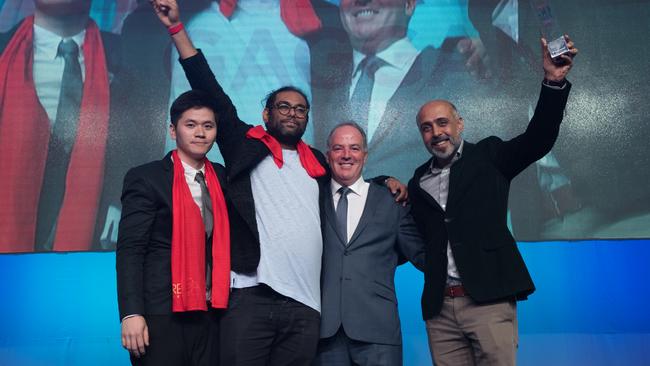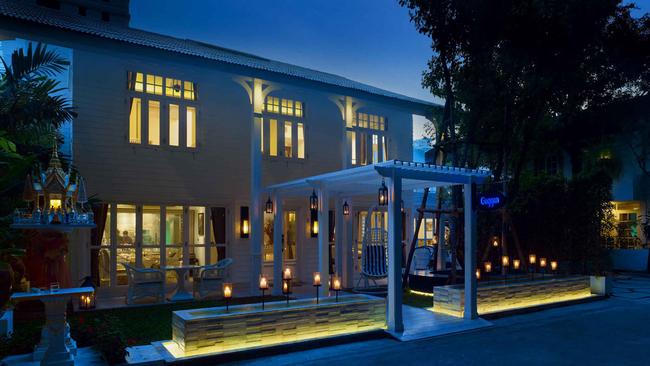Asia’s hottest 50 restaurants
Australian chefs working in the region make their mark.

The message came early in the day; it might as well have read: this is the best oil you’ll get today. “I heard a rumour,” wrote my informant. “Gaggan will retain its #1 spot.”
Like any subject of great importance, no matter how narrow the audience, there is intense speculation attached to the results of an international awards program. Asia’s 50 Best Restaurants is no different. And believe me, this stuff is very important to the people concerned.
It was last Tuesday. We were in Bangkok. And so was every chef and restaurateur of note across the six zones that comprise the eligible voting regions for Asia’s 50 Best. Japan, China, South Korea, Taiwan, India … and all the way to East Timor. It actually represents most of the world’s population.
I caught up with my speculatory and, it would seem, well-connected mate later that evening as we all stood around in the old-world grandeur that is the central courtyard of Sathorn House, in another life Thailand’s Russian embassy. Most of us were nibbling Chiang Mai sausage with sticky rice and blanched galangal while scoffing champagne and mineral water in a losing battle to beat off the moist heat of a still Bangkok night.
“I saw a bloke earlier today,” he says. “He reckons he’s seen the list.”
Indeed he had. Implausible as it seemed at first blush, the Bangkok restaurant of Indian expat Gaggan Anand had, for a third successive year, been voted Asia’s best. Three times in a history of just five years since the award’s inception.
If nothing else, it dispelled any suggestion the organisers themselves play any part in the results (six “academies” comprising about 300 voters, from the worlds of food, wine, publishing and general foodie influence contribute votes that are tabulated to achieve a numerical ranking). For, who within the Asia’s 50/World’s 50 hierarchy could possibly want the same restaurant to win yet again? Does it matter?
Well, it certainly does to the businesses that find themselves in the spotlight.
While many of the chefs involved (they are nearly always chef-driven restaurants) will tell you on the record that they are simply happy to be recognised and that the notion of “best”, with a numerical ranking attached to it, is slightly silly, winning pays bills. Lots of bills.
In societies fixated on brand power and third-party affirmation, the status attached to the Asia’s 50 Best means a blood transfusion to the bookings diary.
Want a table at Gaggan this year? Don’t hold your breath.

And that’s just the commercial starter’s gun for these celebrity chefs with book deals, appearance fees and endorsements all following inclusion in this list.
Asia’s 50 Best came out of the now pervasive World’s 50 Best Restaurants list, started by a trade magazine 14 years ago as a bit of fun, unwittingly creating a monster. The list is now the most frequently quoted yardstick of restaurant worth around the world. The status it has conveyed, and the focus it has turned on countless careers — from Noma’s Rene Redzepi in Denmark to Alex Atala at Brazil’s D.O.M., and all points between — has on a global scale swept other systems, such as Michelin, to one side.
Good or bad? It’s a subject of endless discussion.
And the “50 Best” juggernaut spawned two significant spin-offs: for Latin America and Asia. With the World’s 50 Best coming to Melbourne in April — fundamentally a trade/media event that will subtly reshape the direction of the world’s restaurant industry for the year ahead — the Asian list has great resonance for Australians.
For a certain kind of traveller, it will influence decisions for future holiday and business travel.
It will also provide an interesting yardstick for the region we broadly call our own against Europe, Africa, Latin America and North America.
How, for example, will it deal with anomalies, such as different interpretations by the World’s 50 voting panel of more than 900 when compared with the results achieved by Asia’s voters?
Last year, for example, the Asia list voted Gaggan ahead of the Tokyo restaurant Narisawa, whereas the World list saw it quite differently, putting the Japanese restaurant at 16 and its Bangkok competitor at 23. In either case, after two hours of sweaty, generous pre-event drinks, a time span that would spell mayhem in societies other than Asia, an audience of about 500 moves across to the W Hotel next door and sits down to hear the news.
The scene is more akin to that of a pop concert: screaming, thunderous applause, partisan support, even from so-called media. It’s unusual.
But the news is good for Australia this year, even if we are not part of the region and awards. Many, many Australians are working in food and wine in Asia, from massive hotels — such as Lucas Glanville at Singapore’s Grand Hyatt, to small, stand-alone restaurants such as chef Dallas Cuddy’s Freebird, in Bangkok — and many make their mark on this list.
Tetsuya Wakuda’s Waku Ghin at Singapore’s Marina Bay Sands made No 20 this year. The super high-end Japanese restaurant, sibling to Sydney institution Tetsuya’s, has been a fixture on the list since its opening. As has Nahm, the restaurant at Bangkok’s Metropolitan Hotel where Sydney-raised David Thompson — busy rolling out his Long Chim chain across Australia right now — is the founding chef and consultant.
A previous “winner” of the title Asia’s Best, Nahm — a glamorous restaurant that is home to uncompromising Thai food with almost archeological authenticity, such is Thompson’s approach to his adopted home — now sits at position five.
A Bangkok veteran of nearly two decades, Barossa-raised Darren Hausler’s contemporary bistro Eat Me, a fixture on the list, came in at 31; Canberra-born chef Dylan Jones and his wife Duangporn (Bo) have continued to make friends at their eco-focused contemporary Thai restaurant Bo.Lan, and it made position 19 this year. Indeed, an impassioned, impromptu speech by Bo Songvisava at a pre-awards seminar on the horror of Thailand’s plastic waste problem was probably the least predictable thing to happen at the awards for years.
But perhaps the most gratifying result was that achieved by Perth-raised Dave Pynt, the chef who has found his feet in Singapore at the unashamedly Australian Burnt Ends, the charcoal/fire-driven little restaurant in Chinatown that continues to build momentum, four years in. Not only was Pynt named winner of the Chef’s Choice award, a peer-voted accolade, but Burnt Ends moved up to 10 on the list.
What that almost certainly means is that Pynt will be in Melbourne in April and that Burnt Ends has a very real chance of being in the World’s 50 Best this year, a bump that will need the restaurant to rise by at least 20 places from its current position of 70. Stranger things have happened.
Indeed, many of the stars of last week’s show will be in Melbourne for the World’s Best gongs. Along with Pynt, as would seem likely, there will undoubtedly be Thompson, Yoshihiro Narisawa of Tokyo, fellow countryman Seiji Yamamoto of Tokyo’s Nihonryori Ryugin, Taiwan-born Singapore-based chef Andre Chiang of Restaurant Andre (No 2 on the 2017 Asia list); Frenchman Paul Pairet of Shanghai’s Ultraviolet, and Dutchman Richard Ekkebus of Amber, in Hong Kong.
And, of course, Gaggan Anand, the personable, humble and, most would agree, quite surprised chef with the number “1” on his jumper.
Will there be a tip-off the morning of April 5? We can only hope.
Asia’s 50 Best Restaurant Awards are sponsored by S. Pellegrino and Acqua Panna. John Lethlean was a guest in Bangkok of S. Pellegrino Asia Pacific.
